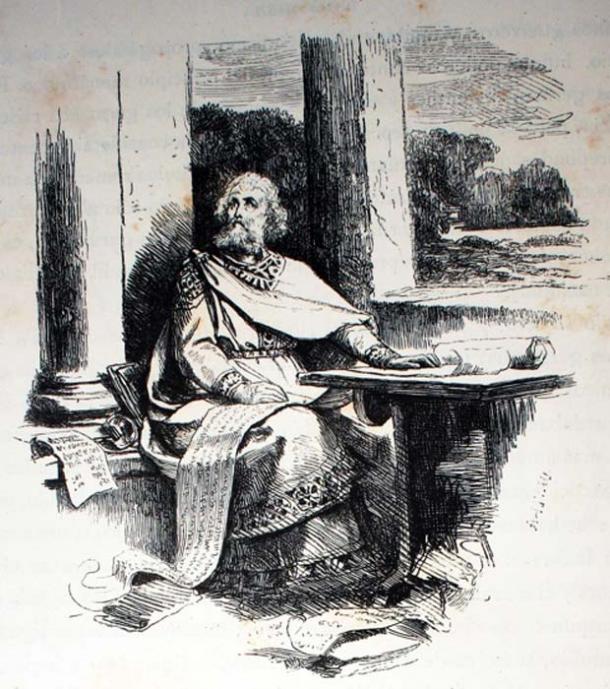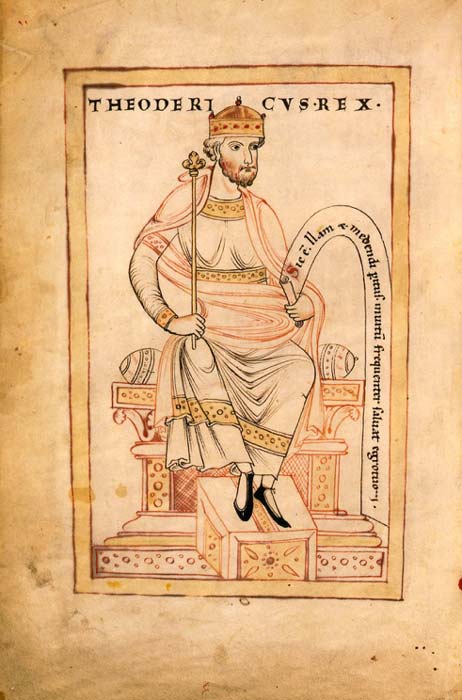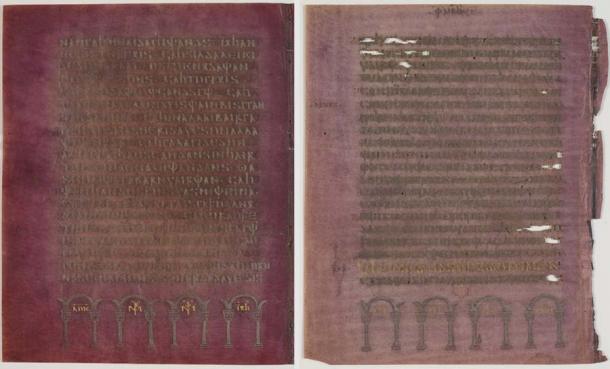
The Mysterious Codex Argenteus: Famed Silver Bible of the Goths
The Goths, one of the major Germanic tribes of ancient times, were a key player in the events that marked the downfall of the Western Roman Empire. Although their era lasted only a few centuries, their conquests nonetheless contributed greatly to the emergence of the early medieval period. They were also the very first of the Germanic peoples to adopt Christianity. The Codex Argenteus is thus one of the instrumental relics of this early Christian Gothic tradition, and is truly a masterpiece amongst all early medieval religious manuscripts. Also known as the Silver Bible, the Codex Argenteus experienced a truly turbulent journey through history.

Bishop Ulfilas created the famed Codex Argenteus. This lavish, extravagant manuscript was a translation of the Bible into the Gothic language. (Fondo Antiguo de la Biblioteca de la Universidad de Sevilla / CC BY 2.0)
Who Made the Codex Argenteus and Why?
The Goths emerged on the historical scene in Europe suddenly. The earliest reports about Goths are generally attributed to Greco-Roman writers. They mention the Gothic tribes that dwelt beyond the Danube River, in what is today Moldova and Ukraine. Of course, these tribes didn’t simply emerge out of thin air.
Some Roman notes predate these sources, mentioning certain Gutones around the Vistula River in 1st century AD. These were most likely the early predecessors of the Goths proper. Either way, it is commonly agreed amongst scholars that the Goths formed out of the regional Wielbark culture, an archaeological complex based in modern day Poland. It had a distinct early Germanic character and shows great similarities with the later Gothic culture.
- Theodoric the Great and His Ostrogothic Mausoleum
- Saintly Leader, or Vengeful Opportunist? The Story of Vladimir the Great
- The Long Goodbye to Scandinavian Paganism and the Christianization of Three Realms
Throughout their turbulent history, the Goths were very prone to migrations. The Gothic historian from the Eastern Roman Empire, Jordanes, (6 th century AD) wrote in his history of the Goths that they supposedly originated from southern Scandinavia, a whole millennia before his time. While such a claim was somewhat far-fetched, it is nonetheless a distinct possibility if we consider the history of the Germanic tribes.
The ferocious and wanderlust-filled Goths became the big trouble-stirrers of early medieval Europe. They sacked Rome and hastened the Fall of the Western Roman Empire, and later moved into Spain to form their own kingdom. Their two major tribes were the Visigoths and the Ostrogoths. The latter were conquered in the 6th century, and the former in the 8th. After that the Goths rapidly lost their identity forever.

The Codex Argenteus is believed to have been commissioned by or for the Ostrogothic King Theodoric the Great. (Public domain)
Nevertheless, their short history was quite eventful. They were the first of the Germanic tribes to adopt Christianity. This was thanks to Bishop Ulfilas. This bishop was of Goth upbringing himself, his name being Wulfilas (meaning “Little Wolf”) in the original spelling. He was not an ethnic Goth, though, as his origins were Cappadocian Greek - he was enslaved by the Goths as a boy and brought up amongst them.
Bishop Ulfilas was not just instrumental in converting the Goths into Christianity, but was also the main creator of the famed Codex Argenteus. This lavish, extravagant manuscript was a translation of the Bible into the Gothic language. It helped with the conversion, for sure, but it was also a high-status symbol, and an item of great worth.

Bishop Ulfilas was instrumental in converting the Goths into Christianity. (Public domain)
The Silver Bible: A Status Symbol for a Powerful King
It is most likely that the Codex Argenteus was commissioned by or for the glorious Ostrogothic King, Theodoric the Great. This task was handled by Bishop Ulfilas, alongside his students and scholars. However, one major obstacle lay before them: how to effectively translate the Holy Bible into the Gothic language, adapting it to the unique voices and pronunciations of their speech? To achieve this, Bishop Ulfilas created the special Gothic alphabet with the accompanying script.
This script was based on the uncial forms of the Greek alphabet, to which he added several unique letters to represent the Gothic phonology. With this new alphabet Ulfilas could translate the Bible with surprising ease. Most scholars agree that Ulfilas avoided the pre-existing Runic alphabet on purpose, which was known to the Goths. He did so to make the process of Christianization easier, as the Runic script still held a lot of Pagan heritage and was connected with many heathen rituals and symbols.
Ulfilas - with a small flock of early Christian converts - was granted permission by Roman Emperor Constantinus II to settle in the city of Nicopolis Ad Istrum (in modern-day Bulgaria) where he worked on the development of the Gothic alphabet. However, it was seemingly not here that he and his followers created the Codex Argenteus. This was supposedly done either in Brescia or in Ravenna, which were both at the time the major cities of Theodoric the Great.

The quality of the Codex Argenteus manuscript is clearly evident. The purple parchment is covered in silver and gold ink. (Magnus Hjalmarsson - Uppsala University Library / Public Domain)
Codex Argenteus: A Lavish and Regal Tome
The luxury and the richness of the Codex is easily observed from just a single glance, signifying its commission for a great King. It was written on fine vellum (calf skin) stained with a royal purple color. This is known as “purple parchment” and was a clear sign of wealth. At the time, the color purple was extremely hard and demanding to acquire, and was thus extremely expensive in any form, reserved only for the most powerful rulers in Europe. Furthermore, the Codex Argenteus was written with luxurious gold and silver inks, and finished with a rich treasure binding - adorned with precious stones and metals.
Alas, as richly made as it was, the Codex was quickly overshadowed. After the reign of Theodoric the Great, it disappeared without a trace. No inventories or writings mentioned it at all. This was without a doubt a result of the rapidly waning influence of the Goths. After they were defeated in the Italian Peninsula and the Gothic rule came to an end, all Gothic manuscripts were essentially useless in Italy, where Latin was still a dominant language.
It can be deduced that the Codex Argenteus lost value and was no longer significant, disappearing from view, but only for a time. After 1,000 years, the Codex resurfaced in the mid-16th century in the libraries of Werden Abbey in Germany. Located close to the river Ruhr and near the city of Essen, the Benedictine monastery was always an important religious center in the region and one of - if not the - richest monasteries in the Holy Roman Empire. But how the Codex arrived here is not known. What its journey until that time was like, no one knows - but a millennia of adventure did take its toll on this holy book.
To the monks it was known simply as the “Silver Book” (Codex Argenteus in Latin), most likely due to the luxury silver ink used for the lettering. It was first mentioned after this in 1569 by the Dutch linguist Johannes Goropius Becanes who recognized its importance. Alas, out of the original 336 folios (pages), only 187 survived the thousand-year journey. From this “re-discovery” in the 16th century, the crazy journey of the Codex Argenteus began, and it constantly changed hands, as a luxury and priceless religious item.

The Swedish nobleman Magnus Gabriel De la Gardie and his wife, Maria Euphrosyne of Zweibrücken purchased the Codex Argenteus in 1662 and commissioned a lavish silver binding for it, before presenting it to University of Uppsala in 1669. (Public domain)
A Wild Journey Around Europe
The codex next found itself in the hands of a very important person - the Holy Roman Emperor Rudolph II. This key ruler and a member of the Habsburg dynasty was known as a patron of arts, and it was most likely that he acquired the book after recognizing its age and importance. However, he would soon find himself without it.
As a consequence of the Thirty Years’ War, in its last year, 1648, the Swedes attacked Prague and managed to sack most of the city. Due to this, the Codex Argenteus and many other lavish items that were kept in the Imperial Castle at Hradcany fell into their hands. From then on it is stored in the depositories of the Royal Library of the Swedish Queen Christina in Stockholm.
However, not long after it changed hands yet again. The Queen abdicated in 1654 and the Codex Argenteus was acquired by the former librarian, a Dutchman named Isaac Voss who took it with him to the Netherlands. Voss was a man known to be a great eccentric, but also a renowned manuscript collector. Still, the book continued its journey and in 1662 it was purchased from Voss by a Swedish Count, Magnus Gabriel De la Gardie.
The Count took the Codex back to Stockholm and there commissioned the manufacture of a lavish chased silver binding, which was made from the designs by the painter David Klöcker Ehrenstrahl. Afterwards, Count de la Gardie presented the touched up Codex Argenteus to the University of Uppsala in 1669. There it has remained ever since - but it doesn’t mean that its journeys had come to an end. When certain parts of the Codex went on display in 1995 they were stolen. Luckily, they were retrieved just a month later, discovered in a storage box at the central railway station in Stockholm!

The lavish silver cover of the Codex Argenteus was commissioned by Magnus Gabriel De la Gardie. (Uppsala University Library / Public domain)
The Incomplete Script of the Codex Argenteus
Earlier on we mentioned that only 188 of the original 336 pages survived to the present day. But for a long time there were only 187 pages surviving. The 188th page was discovered in 1970. It is the last page of the original Codex, folio number 336, and was found in the city of Speyer in Germany - almost accidentally.
In 1970 the town’s St. Afra Chapel was undergoing restoration, during which a small wooden reliquary was found. The reliquary originally came from the German city of Aschaffenburg in Bavaria. Within this small wooden box was housed a thin wooden staff - the folio 336 was carefully rolled around it. How it ended up there remains a mystery.
Today, the Codex Argenteus remains the foremost source for studying the forgotten Gothic language. One of the enigmatic East Germanic languages, Gothic has been extinct for many long centuries. Some scholars say that Gothic managed to survive all the way until 1945 as the Crimean Gothic dialect, but no sources of it exist. Other than the Codex Argenteus, the sources of the original Gothic language are few, and that is why it is so precious.
A few snippets can be found here and there: a few palimpsests (reused pages) with Gothic exist in the Codex Carolinus in Wolfenbüttel, the Ambrosiani Codices in Milan, in the Codex Taurinensis in Torino, and the second-most important Gothic language manuscript, the Skeireins fragments in Milan and the Vatican Library. There are also a few small notes written in manuscript margins, and a short fragment of a Gothic text written in Gothic-Latin, found in Egypt and subsequently lost in a flood in Giessen in Germany, in the 1940’s. These little snippets are not enough to provide a valuable source of Gothic language, so the Codex Argenteus remains the most important.

After its long journey, the Codex Argenteus, or Silver Bible, is now kept at Uppsala University Library encased in bulletproof glass. (Uppsala University Library)
The Mysterious Medieval Manuscript
There are still plenty of mysteries related to the Codex Argenteus, some of which remain as great puzzles for scholars across the world. First and foremost is the question of the remaining 148 folios of the manuscript and theirr whereabouts are unknown. The second mystery is the solitary leaf found in the Speyer cathedral. How did it get there? Lastly, the third enigma is the so-called “Thousand Year Journey” of the Codex: where was it for such a long time until it was discovered in a library of the Benedictine Monastery in Werden?
Several scholars have proposed their own theses and ideas. Some argue that the codex remained in Ravenna after the fall of Theodoric the Great, and was found there by Charlemagne some two centuries later and brought to Aachen, from where it was later brought to Werden, which is a short distance away. Others simply say that the Gothic treasures had a wild journey across Europe, or that the codex was relocated to Formia in Italy, where it was found by Saint Ludger who took it with him and later founded the Werden monastery in 799, storing the book there.
Either way, the mystery remains. The fate of the missing pages remains unknown, although hope still lingers that they will be discovered. Nevertheless, what we have today is a valuable resource for studying the forgotten Gothic language. The Codex Argenteus provides crucial insight into the early Christianization of the Germanic peoples, as well as a glimpse into the history of a powerful and restless Germanic tribe - the Goths.
Top image: After an eventful history, the Codex Argenteus can now be viewed at Uppsala University Library in Sweden. Source: (Magnus Hjalmarsson - Uppsala University Library / CC BY 4.0)
By Aleksa Vučković
References
Bigus, M. 2011. “Codex Argenteus and the Political Ideology in the Ostrogothic Kingdom” in Medievalists. Available at: https://www.medievalists.net/2012/07/codex-argenteus-and-political-ideology-in-the-ostrogothic-kingdom/
Munkhammar, L. 1998. Codex Argenteus, From Ravenna to Uppsala. Uppsala University Library.
Norman, J. 2021. “The Codex Argenteus, the Primary Surviving Example of the Gothic Language” in Jeremy Norman’s History of Information. Available at: https://www.historyofinformation.com/detail.php?id=1399
















Comments
And don’t forget about the city of Gothenburg in Sweden!
How is it far fetched that the Goths came from near Scandanavia? They literally have an island called Gotland or Gothland depending on the era.